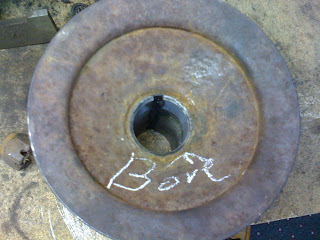Besides attending underground rock shows

visiting old steam locomotives

and B-17 bombers

I also picked up a set of circa 1942-45 Plomb combination wrenches

which helped sate a lust for these tools I mentioned in this post.
Meanwhile, on the hot rod front, I had the inside bore of my front pulley machined to fit (it was too snug before).

Once that was done, I was able to install the pulley and set the intake manifold and fan assembly on the motor to see if the pulleys all line up. Thankfully, they do.

Then, today my friend from Okieville stopped by unexpectedly, but gave me a hand on the motor. First, we checked the connecting rod bearings (well, one at least) to see if we could tell if the crankshaft is standard or has been turned (under standard measurement).

Since the insert bearing (as I apparently have an entire 8BA rotating assembly (crankshaft, connecting rods, and pistons) did not have a measurement number on it, we just recorded the part numbers on it for lookup later.

Let me tell you that flipping that motor over (upside down) on that flathead stand gave me the willies. All I could imagine was the mounting bolts stripping out of the block and dropping the motor onto the stand, floor, and me. My friend assured me it would be fine. It was.
He also showed me the timing marks on the crankshaft and timing gears.

I can't recall if I've written that this motor already has an aluminum timing gear. The more we dug into this motor today, the more my friend's convinced it'll be a real ugly duckling that will (hopefully) turn into a beautiful(ly tuned) swan. We'll see.
After checking the bearing, we installed the two "dog turd" front crankshaft seals into the timing cover and oil pan. (This is a new one).

I'd been soaking it in oil, on the advice of my flathead friends. What was to have been a few days amounted to a few months, but I can't believe that would affect anything. Then, we heroically struggled to install the timing cover and crank pulley. The pulley wouldn't slide into place because of the still-swollen front seal. Finally, we drove the pulley home with a BFH and driver.
Once the front was buttoned up, we removed the old and installed the new rear main seal (cork) (this is the old one)

and installed the oil pan. I'm so glad we flipped the motor over. Installing that heavy pan and the gaskets would have been very difficult with the motor right side up. Here are the results:
Front seal

Rear main seal

Scary upside down motor with oil pan installed

Finally, there's always something when combining disparate Ford parts into a hot rod, and here's today's. Following my friend's recommendation, I installed the starter so I wouldn't have to fool with it once the motor's in the frame. After some discussion as to whether the Bendix should be in or out, I installed it in the "out" (not against the flywheel) position. After tightening it up, I went to turn the motor over with a breaker bar on the front pulley, just for kicks. In doing so, however, the starter Bendix clashed with the flywheel with a "clang." Figuring I'd put the Bendix in the wrong position, and at my friend's urging, I continued to rotate the motor, but it continued to clang. Knowing something was wrong, we looked to see that, even in its fully "out" position, the Bendix was still meshing with the ring gear.
We futzed with it a little, but have come to the conclusion that, since I'm using a '49-'50 Merc flywheel, and have a '49-'53 rotating assembly, perhaps I now need to use a '49-'53 starter and/or Bendix to clear the ring gear. Oh, well, I'm going to borrow my uncle's '50 Ford starter to see what differences, if any, there are between his and mine.
Results in the next post.
-30-





No comments:
Post a Comment